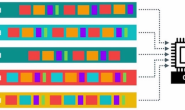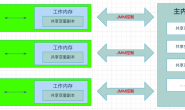1.说明
Stream 是 Java8 中处理集合的关键抽象概念,它可以指定你希望对集合进行的操作,可以执行非常复杂的查找、过滤和映射数据等操作。 使用Stream API 对集合数据进行操作,就类似于使用 SQL 执行的数据库查询。也可以使用 Stream API 来并行执行操作。简言之,Stream API 提供了一种高效且易于使用的处理数据的方式。
2.什么是Stream
是数据渠道,用于操作数据源(集合、数组等)所生成的元素序列。
Stream 和 Collection 集合的区别:Collection 是一种静态的内存数据结构,讲的是数据,而 Stream 是有关计算的,讲的是计算。前者是主要面向内存,存储在内存中,后者主要是面向 CPU,通过 CPU 实现计算。
集合讲的是数据,Stream讲的是计算
注意:
①Stream 自己不会存储元素。
②Stream 不会改变源对象。相反,他们会返回一个持有结果的新Stream。
③Stream 操作是延迟执行的。这意味着他们会等到需要结果的时候才执行。
3.Stream的操作三个步骤
1- 创建 Stream 一个数据源(如:集合、数组),获取一个流
2- 中间操作:对数据源的数据进行处理
多个中间操作可以连接起来形成一个流水线,除非流水线上触发终止操作,否则 中间操作不会执行任何的处理!而在终止操作时一次性全部处理,称为”惰性求值”。
3- 终止操作(终端操作)
一旦执行终止操作,就执行中间操作链,并产生结果。之后,不会再被使用
4.
public class Employee {
private int id;
private String name;
private int age;
private double salary;
//……省略get和set方法……
public Employee() {
System.out.println("Employee().....");
}
public Employee(int id) {
this.id = id;
System.out.println("Employee(int id).....");
}
public Employee(int id, String name) {
this.id = id;
this.name = name;
}
public Employee(int id, String name, int age, double salary) {
this.id = id;
this.name = name;
this.age = age;
this.salary = salary;
}
@Override
public String toString() {
return "Employee{" + "id=" + id + ", name='" + name + '\'' + ", age=" + age + ", salary=" + salary + '}';
}
@Override
public boolean equals(Object o) {
if (this == o)
return true;
if (o == null || getClass() != o.getClass())
return false;
Employee employee = (Employee) o;
if (id != employee.id)
return false;
if (age != employee.age)
return false;
if (Double.compare(employee.salary, salary) != 0)
return false;
return name != null ? name.equals(employee.name) : employee.name == null;
}
@Override
public int hashCode() {
int result;
long temp;
result = id;
result = 31 * result + (name != null ? name.hashCode() : 0);
result = 31 * result + age;
temp = Double.doubleToLongBits(salary);
result = 31 * result + (int) (temp ^ (temp >>> 32));
return result;
}
}
/**
* 提供用于测试的数据
*/
public class EmployeeData {
public static List<Employee> getEmployees(){
List<Employee> list = new ArrayList<>();
list.add(new Employee(1001, "马化腾", 34, 6000.38));
list.add(new Employee(1002, "马云", 12, 9876.12));
list.add(new Employee(1003, "刘强东", 33, 3000.82));
list.add(new Employee(1004, "雷军", 26, 7657.37));
list.add(new Employee(1005, "李彦宏", 65, 5555.32));
list.add(new Employee(1006, "比尔盖茨", 42, 9500.43));
list.add(new Employee(1007, "任正非", 26, 4333.32));
list.add(new Employee(1008, "扎克伯格", 35, 2500.32));
return list;
}
}
5.Stream的实例化
方式一:通过集合
Java8 中的 Collection 接口被扩展,提供了两个获取流的方法:
- default Stream<E> stream() : 返回一个顺序流
- default Stream<E> parallelStream() : 返回一个并行流
@Test
public void test01(){
List<Integer> list = Arrays.asList(1,2,3,4,5);
//JDK1.8中,Collection系列集合增加了方法
Stream<Integer> stream = list.stream();
}
- static <T> Stream<T> stream(T[] array): 返回一个流
- public static IntStream stream(int[] array)
- public static LongStream stream(long[] array)
- public static DoubleStream stream(double[] array)
@Test
public void test02(){
String[] arr = {"hello","world"};
Stream<String> stream = Arrays.stream(arr);
}
@Test
public void test03(){
int[] arr = {1,2,3,4,5};
IntStream stream = Arrays.stream(arr);
}
方式三:通过Stream的of()
可以调用Stream类静态方法 of(), 通过显示值创建一个流。它可以接收任意数量的参数。
- public static<T> Stream<T> of(T… values) : 返回一个流
@Test
public void test04(){
Stream<Integer> stream = Stream.of(1,2,3,4,5);
stream.forEach(System.out::println);
}
可以使用静态方法 Stream.iterate() 和 Stream.generate(), 创建无限流。
- 迭代
public static<T> Stream<T> iterate(final T seed, final UnaryOperator<T> f) - 生成
public static<T> Stream<T> generate(Supplier<T> s)
// 方式四:创建无限流
@Test
public void test05() {
// 迭代
// public static<T> Stream<T> iterate(final T seed, final UnaryOperator<T> f)
// 遍历前10个偶数
Stream<Integer> stream = Stream.iterate(0, x -> x + 2);
stream.limit(10).forEach(System.out::println);
// 生成
// public static<T> Stream<T> generate(Supplier<T> s)
Stream<Double> stream1 = Stream.generate(Math::random);
stream1.limit(10).forEach(System.out::println);
}
6.中间操作:筛选与切片
| 方 法 | 描 述 |
|---|---|
| filter(Predicatep) | 接收 Lambda , 从流中排除某些元素 |
| distinct() | 筛选,通过流所生成元素的 hashCode() 和 equals() 去除重复元素 |
| limit(long maxSize) | 截断流,使其元素不超过给定数量 |
| skip(long n) | 跳过元素,返回一个扔掉了前 n 个元素的流。 若流中元素不足 n 个,则返回一个空流。与 limit(n) 互补 |
//筛选与切片
@Test
public void test1(){
List<Employee> list = EmployeeData.getEmployees();
// filter(Predicate p)——接收 Lambda , 从流中排除某些元素。
Stream<Employee> stream = list.stream();
//示例:查询员工表中薪资大于7000的员工信息
stream.filter(e -> e.getSalary() > 7000).forEach(System.out::println);
System.out.println();
// distinct()——筛选,通过流所生成元素的 hashCode() 和 equals() 去除重复元素
list.add(new Employee(1010,"刘强东",40,8000));
list.add(new Employee(1010,"刘强东",41,8000));
list.add(new Employee(1010,"刘强东",40,8000));
list.add(new Employee(1010,"刘强东",40,8000));
list.add(new Employee(1010,"刘强东",40,8000));
list.stream().distinct().forEach(System.out::println);
System.out.println();
// limit(n)——截断流,使其元素不超过给定数量。
list.stream().limit(3).forEach(System.out::println);
System.out.println();
// skip(n) —— 跳过元素,返回一个扔掉了前 n 个元素的流。若流中元素不足 n 个,则返回一个空流。与 limit(n) 互补
list.stream().skip(3).forEach(System.out::println);
}
7.中间操作:映射
| 方法 | 描述 |
|---|---|
| map(Function f) | 接收一个函数作为参数,该函数会被应用到每个元素上,并将其映射成一个新的元素。 |
| mapToDouble(ToDoubleFunction f) | 接收一个函数作为参数,该函数会被应用到每个元素上,产生一个新的 DoubleStream。 |
| mapToInt(ToIntFunction f) | 接收一个函数作为参数,该函数会被应用到每个元素上,产生一个新的 IntStream。 |
| mapToLong(ToLongFunction f) | 接收一个函数作为参数,该函数会被应用到每个元素上,产生一个新的 LongStream。 |
| flatMap(Function f) | 接收一个函数作为参数,将流中的每个值都换成另一个流,然后把所有流连接成一个流 |
//映射
@Test
public void test2(){
// map(Function f)——接收一个函数作为参数,将元素转换成其他形式或提取信息,该函数会被应用到每个元素上,并将其映射成一个新的元素。
List<String> list = Arrays.asList("aa", "bb", "cc", "dd");
// 示例:将数据转为大写字母
list.stream().map(str -> str.toUpperCase()).forEach(System.out::println);
// 示例:获取员工姓名长度大于3的员工的姓名。
List<Employee> employees = EmployeeData.getEmployees();
Stream<String> namesStream = employees.stream().map(Employee::getName);
namesStream.filter(name -> name.length() > 3).forEach(System.out::println);
System.out.println();
// flatMap(Function f)——接收一个函数作为参数,将流中的每个值都换成另一个流,然后把所有流连接成一个流。
Stream<Character> characterStream = list.stream().flatMap(StreamAPITest1::fromStringToStream);
characterStream.forEach(System.out::println);
System.out.println();
}
8.中间操作:排序
| 方法 | 描述 |
|---|---|
| sorted() | 产生一个新流,其中按自然顺序排序 |
| sorted(Comparator com) | 产生一个新流,其中按比较器顺序排序 |
//排序
@Test
public void test4(){
// sorted()——自然排序
List<Integer> list = Arrays.asList(12, 43, 65, 34, 87, 0, -98, 7);
list.stream().sorted().forEach(System.out::println);
// sorted(Comparator com)——定制排序
List<Employee> employees = EmployeeData.getEmployees();
employees.stream().sorted( (e1,e2) -> {
int ageValue = Integer.compare(e1.getAge(),e2.getAge());
if(ageValue != 0){
return ageValue;
}else{
return -Double.compare(e1.getSalary(),e2.getSalary());
}
}).forEach(System.out::println);
}
9.终止操作:匹配与查找
| 方法 | 描述 |
|---|---|
| allMatch(Predicate p) | 检查是否匹配所有元素 |
| anyMatch(Predicate p) | 检查是否至少匹配一个元素 |
| noneMatch(Predicate p) | 检查是否没有匹配所有元素 |
| findFirst() | 返回第一个元素 |
| findAny() | 返回当前流中的任意元素 |
| count() | 返回流中元素总数 |
| max(Comparator c) | 返回流中最大值 |
| min(Comparator c) | 返回流中最小值 |
| forEach(Consumer c) | 内部迭代(使用 Collection 接口需要用户去做迭代,称为外部迭代。 相反,Stream API 使用内部迭代——它帮你把迭代做了) |
//匹配与查找
@Test
public void test1(){
List<Employee> employees = EmployeeData.getEmployees();
// allMatch(Predicate p)——检查是否匹配所有元素。
// 示例:是否所有的员工的年龄都大于18
boolean allMatch = employees.stream().allMatch(e -> e.getAge() > 18);
System.out.println(allMatch);
// anyMatch(Predicate p)——检查是否至少匹配一个元素。
// 示例:是否存在员工的工资大于 10000
boolean anyMatch = employees.stream().anyMatch(e -> e.getSalary() > 10000);
System.out.println(anyMatch);
// noneMatch(Predicate p)——检查是否没有匹配的元素。
// 示例:是否存在员工姓“雷”
boolean noneMatch = employees.stream().noneMatch(e -> e.getName().startsWith("雷"));
System.out.println(noneMatch);
// findFirst——返回第一个元素
Optional<Employee> employee = employees.stream().findFirst();
System.out.println(employee);
// findAny——返回当前流中的任意元素
Optional<Employee> employee1 = employees.parallelStream().findAny();
System.out.println(employee1);
// count——返回流中元素的总个数
long count = employees.stream().filter(e -> e.getSalary() > 5000).count();
System.out.println(count);
// max(Comparator c)——返回流中最大值
// 示例:返回最高的工资:
Stream<Double> salaryStream = employees.stream().map(e -> e.getSalary());
Optional<Double> maxSalary = salaryStream.max(Double::compare);
System.out.println(maxSalary);
// min(Comparator c)——返回流中最小值
// 示例:返回最低工资的员工
Optional<Employee> employee2 = employees.stream().min((e1, e2) -> Double.compare(e1.getSalary(), e2.getSalary()));
System.out.println(employee2);
System.out.println();
// forEach(Consumer c)——内部迭代
employees.stream().forEach(System.out::println);
//使用集合的遍历操作
employees.forEach(System.out::println);
}
10.终止操作:归约
| 方法 | 描述 |
|---|---|
| reduce(T iden, BinaryOperator b) | 可以将流中元素反复结合起来,得到一个值。返回 T |
| reduce(BinaryOperator b) | 可以将流中元素反复结合起来,得到一个值。返回 Optional<T> |
//归约
@Test
public void test3(){
// reduce(T identity, BinaryOperator)——可以将流中元素反复结合起来,得到一个值。返回 T
// 示例:计算1-10的自然数的和
List<Integer> list = Arrays.asList(1,2,3,4,5,6,7,8,9,10);
Integer sum = list.stream().reduce(0, Integer::sum);
System.out.println(sum);
// reduce(BinaryOperator) ——可以将流中元素反复结合起来,得到一个值。返回 Optional<T>
// 示例:计算公司所有员工工资的总和
List<Employee> employees = EmployeeData.getEmployees();
Stream<Double> salaryStream = employees.stream().map(Employee::getSalary);
Optional<Double> sumMoney = salaryStream.reduce((d1,d2) -> d1 + d2);
System.out.println(sumMoney.get());
}
11.终止操作:收集
| 方 法 | 描 述 |
|---|---|
| collect(Collector c) | 将流转换为其他形式。接收一个 Collector接口的实现, 用于给Stream中元素做汇总的方法 |
Collector 接口中方法的实现决定了如何对流执行收集的操作(如收集到 List、Set、Map)。
| 返回类型 | 作用 | |
|---|---|---|
| toList | List<T> |
List<Employee> emps= list.stream().collect(Collectors.toList());
| 返回类型 | 作用 | |
|---|---|---|
| toSet | Set<T> |
Set<Employee> emps= list.stream().collect(Collectors.toSet());
| 返回类型 | 作用 | |
|---|---|---|
| toCollection | Collection<T> |
Collection<Employee> emps =list.stream().collect(Collectors.toCollection(ArrayList::new));
| 返回类型 | 作用 | |
|---|---|---|
| counting | Long |
long count = list.stream().collect(Collectors.counting());
| 返回类型 | 作用 | |
|---|---|---|
| summingInt | Integer |
int total=list.stream().collect(Collectors.summingInt(Employee::getSalary));
| 返回类型 | 作用 | |
|---|---|---|
| averagingInt | Double |
double avg = list.stream().collect(Collectors.averagingInt(Employee::getSalary));
| 返回类型 | 作用 | |
|---|---|---|
| summarizingInt | IntSummaryStatistics |
int SummaryStatisticsiss= list.stream().collect(Collectors.summarizingInt(Employee::getSalary));
| 返回类型 | 作用 | |
|---|---|---|
| joining | String |
String str= list.stream().map(Employee::getName).collect(Collectors.joining());
| 返回类型 | 作用 | |
|---|---|---|
| maxBy | Optional<T> |
Optional<Emp>max= list.stream().collect(Collectors.maxBy(comparingInt(Employee::getSalary)));
| 返回类型 | 作用 | |
|---|---|---|
| minBy | Optional<T> |
Optional<Emp> min = list.stream().collect(Collectors.minBy(comparingInt(Employee::getSalary)));
| 返回类型 | 作用 | |
|---|---|---|
| reducing | 归约产生的类型 |
int total=list.stream().collect(Collectors.reducing(0, Employee::getSalar, Integer::sum));
| 返回类型 | 作用 | |
|---|---|---|
| collectingAndThen | 转换函数返回的类型 |
int how= list.stream().collect(Collectors.collectingAndThen(Collectors.toList(), List::size));
| 返回类型 | 作用 | |
|---|---|---|
| groupingBy | Map<K, List<T>> |
Map<Emp.Status, List<Emp>> map= list.stream().collect(Collectors.groupingBy(Employee::getStatus));
| 返回类型 | 作用 | |
|---|---|---|
| partitioningBy | Map<Boolean, List<T>> |
Map<Boolean,List<Emp>> vd = list.stream().collect(Collectors.partitioningBy(Employee::getManage));
转载请注明:西门飞冰的博客 » JAVA基础—StreamAPI




